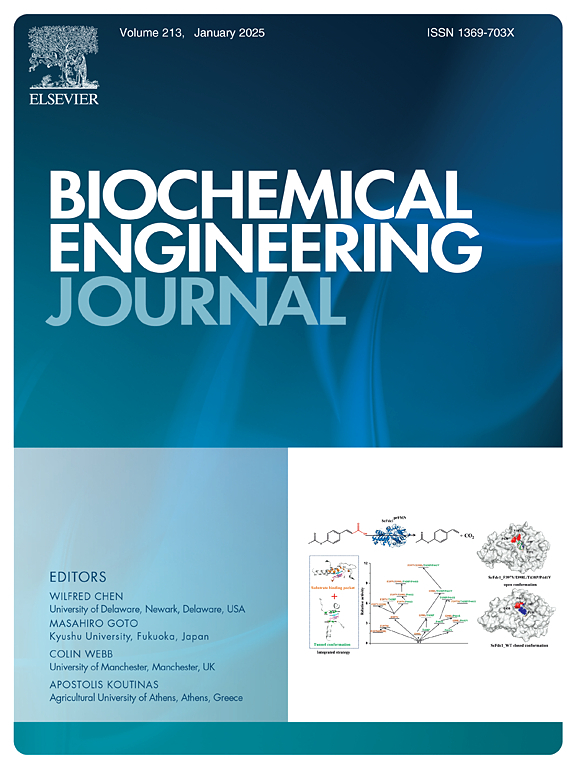使用非卤化溶剂从巨栉藻中提取聚(3-羟基丁酸酯):性能比较分析
IF 3.7
3区 生物学
Q2 BIOTECHNOLOGY & APPLIED MICROBIOLOGY
引用次数: 0
摘要
使用氯仿进行溶剂萃取是从干燥生物质中回收聚(3-羟基丁酸)(P(3HB))的最常见工业工艺,这仍然是扩大这种可生物降解的生物聚合物商业应用的主要障碍。因此,人们对这一工艺的非卤化溶剂替代品产生了浓厚的兴趣,文献中也有一些从革兰氏阴性细菌中回收 P(3HB) 的相关结果。这项工作评估了一组非卤代溶剂从巨头普氏菌(一种具有生产 P(3HB)巨大潜力的革兰氏阳性细菌)中提取 P(3HB)的潜力。对乙酸乙酯(EtAc)、丁酮(MEK)、碳酸二甲酯(DMC)、二甲基亚砜(DMSO)、N,N-二甲基乙酰胺(NNDA)、2-庚酮(2-Hp)、碳酸丙烯酯(PC)和丙酸异戊酯(IAP)进行了测试。使用商用 P(3HB)进行的初步增溶测试表明,EtAc、MEK、DMC 和 IAP 的 P(3HB)增溶能力(EtAc、MEK 和 DMC 低于 0.08 g/L;IAP 低于 1.3-2.5 g/L)低于 DMSO(65-70 g/L)和 PC、2-Hp 和 NNDA(100 g/L)。然后,仅对 DMSO、PC、2-Hp 和 NNDA 进行了细胞内 P(3HB) 恢复试验评估。DMSO 对 P(3HB) 没有选择性,会导致细胞壁成分被消化。PC、2-Hp 和 NNDA 的性能优于氯仿,但 NNDA 的回收率更高(98.5%,30 分钟,140 ºC)。本文章由计算机程序翻译,如有差异,请以英文原文为准。
Extraction of poly(3-hydroxybutirate) from Priestia megaterium using non-halogenated solvents: A comparative performance analysis
Solvent extraction using chloroform is the most common industrial process for poly(3-hydroxybutyrate) (P(3HB)) recovery from dried biomass, and still a major barrier to expanding the commercial application of this biodegradable biopolymer. Consequently, there is great interest in alternative non-halogenated solvents for this process and some relevant related results are available in the literature for P(3HB) recovery from Gram-negative bacteria. This work evaluated the potential of a set of non-halogenated solvents for the extraction of P(3HB) from Priestia megaterium, a Gram-positive bacterium of great potential for P(3HB) production. Ethyl acetate (EtAc), methyl ethyl ketone (MEK), dimethyl carbonate (DMC), dimethyl sulfoxide (DMSO), N,N-dimethylacetamide (NNDA), 2-heptanone (2-Hp), propylene carbonate (PC), and isoamyl propionate (IAP) were tested. Preliminary solubilization tests using commercial P(3HB) showed that EtAc, MEK, DMC and IAP had lower P(3HB) solubilization capacity (below 0.08 g/L for EtAc, MEK, and DMC; 1.3–2.5 g/L for IAP) than DMSO (65–70 g/L) and PC, 2-Hp and NNDA (>100 g/L). Then, only DMSO, PC, 2-Hp, and NNDA were evaluated in recovery tests with intracellular P(3HB). DMSO was not selective for P(3HB), causing digestion of cell wall components. PC, 2-Hp, and NNDA outperformed chloroform, but NNDA stood out for its remarkably higher recovery (98.5 %, 30 min, 140 ºC).
求助全文
通过发布文献求助,成功后即可免费获取论文全文。
去求助
来源期刊

Biochemical Engineering Journal
工程技术-工程:化工
CiteScore
7.10
自引率
5.10%
发文量
380
审稿时长
34 days
期刊介绍:
The Biochemical Engineering Journal aims to promote progress in the crucial chemical engineering aspects of the development of biological processes associated with everything from raw materials preparation to product recovery relevant to industries as diverse as medical/healthcare, industrial biotechnology, and environmental biotechnology.
The Journal welcomes full length original research papers, short communications, and review papers* in the following research fields:
Biocatalysis (enzyme or microbial) and biotransformations, including immobilized biocatalyst preparation and kinetics
Biosensors and Biodevices including biofabrication and novel fuel cell development
Bioseparations including scale-up and protein refolding/renaturation
Environmental Bioengineering including bioconversion, bioremediation, and microbial fuel cells
Bioreactor Systems including characterization, optimization and scale-up
Bioresources and Biorefinery Engineering including biomass conversion, biofuels, bioenergy, and optimization
Industrial Biotechnology including specialty chemicals, platform chemicals and neutraceuticals
Biomaterials and Tissue Engineering including bioartificial organs, cell encapsulation, and controlled release
Cell Culture Engineering (plant, animal or insect cells) including viral vectors, monoclonal antibodies, recombinant proteins, vaccines, and secondary metabolites
Cell Therapies and Stem Cells including pluripotent, mesenchymal and hematopoietic stem cells; immunotherapies; tissue-specific differentiation; and cryopreservation
Metabolic Engineering, Systems and Synthetic Biology including OMICS, bioinformatics, in silico biology, and metabolic flux analysis
Protein Engineering including enzyme engineering and directed evolution.
 求助内容:
求助内容: 应助结果提醒方式:
应助结果提醒方式:


